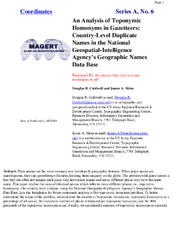| dc.description.abstract | Place names are the most common way we identify geographic features. When place names are unambiguous, they can georeference features, locating them uniquely on the globe. The problem with place names is that they are often not unique; each place may have many names and many different places may have the same name. This paper studies the issue of identical names which refer to many different places, i.e., toponymic homonyms. Our country level analysis, using the National Geospatial-Intelligence Agency’s Geographic Names Data Base, lays the foundation for future systematic analysis of the toponymic homonym problem. To better understand the scope of the problem, we evaluated the number of toponymic homonyms, toponymic homonyms as a percentage of all names, the maximum number of places referenced per toponymic homonym, and the 90th percentile of thetoponymic homonym count. Finally, we calculated a measure of toponymic homonym complexity. | en |


